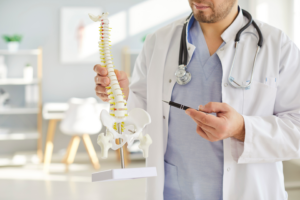HOW IS IT INJURED AND WHO NEEDS SURGERY?


The anterior cruciate ligament (ACL) is one of the main stabilizers of the knee. The media is full of reports of injuries to athletes’ ACLs and their subsequent surgeries. Despite this, few people have a comfortable understanding of the actual injury and possible treatments available.
The knee consists of two bones that are held together by an arrangement of four ligaments which permit a stable range of motion. Ligaments are specialized bundles of collagen (like a rope) that connect one bone to another. The anterior cruciate ligament (ACL) functions to prevent the tibia from sliding forward under the femur and prevents a form of rotation (or pivot). This knee ligament is important for athletic maneuvers that require sudden stopping, twisting, or change in direction. A knee with a torn ACL is like a car with bad brakes. If the motion is simply straight ahead without much stopping or turning (i.e. biking or rowing), then the knee may perform relatively well. If however, the sport requires rapid changes in direction (i.e. football, soccer, basketball), then the knee may be unstable and give way.
The injury to an ACL can occur in many different situations. The knee may be entangled or twisted during a collision during a sport. However, the injury is frequently non-contact, when the athlete simply twists or rotates the knee when the foot is planted on the ground. When injured, the player may feel or hear a “pop.” It is important to not return to sports after a major injury until examined by a physician.
The diagnosis is usually evident by an orthopedic physical exam. X-rays are necessary to ensure that there are no accompanying fractures of the bones. Generally, an MRI scan will be ordered to evaluate possible associated injuries, such as the meniscus. Once all of the injuries have been identified, decisions must be made regarding treatment.
Unfortunately, a torn ACL does not generally heal itself enough to make the knee fully stable. Partial, or incomplete injures to the ligament are rare and most ACL injuries are complete tears. The treatment of a player with an injured ACL is based on the specifics of that individual. Age is especially important in adolescent patients (usually those under 15 years old) when the growth plates are still open in the knee. Associated injuries, such as a torn meniscus cartilage, may influence the need for surgery and the timing of any surgery planned.
Prevention of ACL tears remains an important goal of sports medicine physicians, but there are not any concrete means to achieve this yet. Knee braces have not been shown to prevent these injuries. Recently, a great deal of attention has been paid to the ACL tears in female athletes. Certain studies have indicated that girls may have a higher rate of injury than boys in certain sports, especially soccer and basketball. There are currently many theories as to why this may be occur. Conditioning and minimizing excessive competition remains the conservative prevention advice.
A knee without an ACL may give way under stress, causing further injury. There are essentially two main forms of treatment for a torn ACL. One is conservative or non-operative. This involves rehabilitation to restore motion and strength to the knee and possibly the use of a knee brace. Unfortunately, a brace cannot fully restore stability and sport participation may lead damage of the cartilage In fact, a large percentage of people with torn ACLs who continue to play sports will further injure their knee.
Many different approaches have been used to surgically treat an ACL injured knee. Techniques have evolved and knowledge has been gained as orthopedists study the knee and the results of surgery. This is called reconstruction of the ACL. Reconstruction means building a new ACL out of tissue. The tissue used to make a new ligament is called the graft. The details of the surgical technique as well as choices of graft will differ among surgeons, but this article will concentrate on discussing the main philosophy of our practice with athletes.
For the most part, the surgery is done with arthroscopy. This is the small lens attached to a camera that allows the surgeon to work throughout the knee through tiny incisions in the skin. During this part of the procedure, any tears of the meniscus are addressed by either repairing the meniscus or trimming away the torn tissue.
The graft used may come from several different sources. Artificial ligaments had been used in the past and the results were very disappointing. They are no longer used. The tissue, or graft, used to reconstruct the ACL is decided before surgery. This tissue may come from the patient’s own body. We tend to favor using a portion of the patellar tendon in high demand athletes. The patellar tendon is the band of tissue that runs from the bottom of the kneecap in the front of the knee down to the leg bone (tibia). We take only the middle portion of the tendon for graft and this region of the patellar tendon generally heals well.
Another graft option is a section of the patient’s hamstring tendons. We personally do not use this graft for several concerns, including a possibly higher rate of reinjury in athletes. Finally, one may use a graft obtained from a cadaver, called an allograft. There are several pros and cons for this graft choice. In younger patients, unfortunately, the allograft may have a much higher retear rate than a patient’s own tissue.
At the surgery, small holes are drilled through the tibia (shin bone) and femur (thigh bone) to make “tunnels” that the graft will be passed through. The graft is anchored within the tunnels at either end. At surgery, we perform a specialized nerve block developed by Dr. Caldwell (insert link) that has been shown to greatly reduce pain and the need for opioid pain medication. In fact, many patients can recover with ibuprofen alone.
Crutches and a brace are used for a short time after surgery until the appropriate motion and control of the leg are regained. Pain and swelling lessen rapidly after the first few days. The ability to walk is progressed until the brace and crutches may be discarded (usually 3-4 weeks after surgery). The rehabilitation after surgery requires time and hard work. Younger patients can generally return to school within a week. The return to sports is based upon motion, strength, balance, and the amount of time since surgery. The graft is continually strengthening during the time after surgery and it needs to gain a large portion of its strength before being stressed during sports. This) depending upon the patient’s age and the type of sports played. Overall, the success rate after reconstruction is quite good. We currently use a specific rehabilitation program to maximize the potential of the knee.




